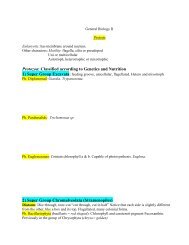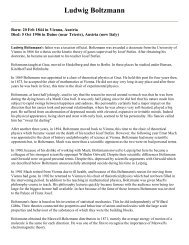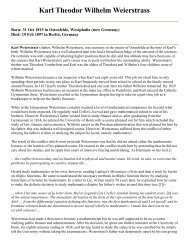Johann Bernoulli - Collin
Johann Bernoulli - Collin
Johann Bernoulli - Collin
You also want an ePaper? Increase the reach of your titles
YUMPU automatically turns print PDFs into web optimized ePapers that Google loves.
Born: 27 July 1667 in Basel, Switzerland<br />
Died: 1 Jan 1748 in Basel, Switzerland<br />
<strong>Johann</strong> <strong>Bernoulli</strong><br />
<strong>Johann</strong> <strong>Bernoulli</strong> was the tenth child of Nicolaus and Margaretha <strong>Bernoulli</strong>. He was the brother of Jacob<br />
<strong>Bernoulli</strong> but <strong>Johann</strong> was twelve years younger than his brother Jacob which meant that Jacob was already a<br />
young man while <strong>Johann</strong> was still a child. The two brothers were to have an important influence on each others<br />
mathematical development and it was particularly true that in his early years <strong>Johann</strong> must have been greatly<br />
influenced by seeing Jacob head towards a mathematical career despite the objections of his parents. As to his<br />
education as a child, <strong>Johann</strong> wrote in his autobiography that his parents:-<br />
... spared no trouble or expense to give me a proper education in both morals and religion.<br />
This religion was the Calvinist faith which had forced his grandparents to flee from Antwerp to avoid religious<br />
persecution.<br />
Nicolaus and Margaretha <strong>Bernoulli</strong> tried to set <strong>Johann</strong> on the road to a business career but, despite his father's<br />
strong pushing, <strong>Johann</strong> seemed to be totally unsuited to a future in business. <strong>Johann</strong>'s father had intended him to<br />
take over the family spice business and in 1682, when he was 15 years old, <strong>Johann</strong> worked in the spice trade for<br />
a year but, not liking the work, he did not do well. It was with great reluctance that <strong>Johann</strong>'s father agreed in<br />
1683 to <strong>Johann</strong> entering the University of Basel. The subject that <strong>Johann</strong> <strong>Bernoulli</strong> was to study at university<br />
was medicine, a topic that many members of the <strong>Bernoulli</strong> family ended up studying despite their liking for<br />
mathematics and mathematical physics.<br />
At Basel University <strong>Johann</strong> took courses in medicine but he studied mathematics with his brother Jacob. Jacob<br />
was lecturing on experimental physics at the University of Basel when <strong>Johann</strong> entered the university and it soon<br />
became clear that <strong>Johann</strong>'s time was mostly devoted to studying Leibniz's papers on the calculus with his<br />
brother Jacob. After two years of studying together <strong>Johann</strong> became the equal of his brother in mathematical<br />
skill.<br />
<strong>Johann</strong>'s first publication was on the process of fermentation in 1690, certainly not a mathematical topic but in<br />
1691 <strong>Johann</strong> went to Geneva where he lectured on the differential calculus. From Geneva, <strong>Johann</strong> made his way<br />
to Paris and there he met mathematicians in Malebranche's circle, where the focus of French mathematics was at<br />
that time. There <strong>Johann</strong> met de l'Hôpital and they engaged in deep mathematical conversations. Contrary to<br />
what is commonly said these days, de l'Hôpital was a fine mathematician, perhaps the best mathematician in<br />
Paris at that time, although he was not quite in the same class as <strong>Johann</strong> <strong>Bernoulli</strong>.<br />
de l'Hôpital was delighted to discover that <strong>Johann</strong> <strong>Bernoulli</strong> understood the new calculus methods that Leibniz<br />
had just published and he asked <strong>Johann</strong> to teach him these methods. This <strong>Johann</strong> agreed to do and the lessons<br />
were taught both in Paris and also at de l'Hôpital's country house at Oucques. <strong>Bernoulli</strong> received generous<br />
payment from de l'Hôpital for these lessons, and indeed they were worth a lot for few other people would have<br />
been able to have given them. After <strong>Bernoulli</strong> returned to Basel he still continued his calculus lessons by<br />
correspondence, and this did not come cheap for de l'Hôpital who paid <strong>Bernoulli</strong> half a professor's salary for the<br />
instruction. However it did assure de l'Hôpital of a place in the history of mathematics since he published the<br />
first calculus book Analyse des infiniment petits pour l'intelligence des lignes courbes (1696) which was based<br />
on the lessons that <strong>Johann</strong> <strong>Bernoulli</strong> sent to him.
As one would expect, it upset <strong>Johann</strong> <strong>Bernoulli</strong> greatly that this work did not acknowledge the fact that it was<br />
based on his lectures. The preface of the book contains only the statement:-<br />
And then I am obliged to the gentlemen <strong>Bernoulli</strong> for their many bright ideas; particularly to the younger Mr<br />
<strong>Bernoulli</strong> who is now a professor in Groningen.<br />
The well known de l'Hôpital's rule is contained in this calculus book and it is therefore a result of <strong>Johann</strong><br />
<strong>Bernoulli</strong>. In fact proof that the work was due to <strong>Bernoulli</strong> was not obtained until 1922 when a copy of <strong>Johann</strong><br />
<strong>Bernoulli</strong>'s course made by his nephew Nicolaus(I) <strong>Bernoulli</strong> was found in Basel. <strong>Bernoulli</strong>'s course is virtually<br />
identical with de l'Hôpital's book but it is worth pointing out that de l'Hôpital had corrected a number of errors<br />
such as <strong>Bernoulli</strong>'s mistaken belief that the integral of 1/x is finite. After de l'Hôpital's death in 1704 <strong>Bernoulli</strong><br />
protested strongly that he was the author of de l'Hôpital's calculus book. It appears that the handsome payment<br />
de l'Hôpital made to <strong>Bernoulli</strong> carried with it conditions which prevented him speaking out earlier. However,<br />
few believed <strong>Johann</strong> <strong>Bernoulli</strong> until the proofs discovered in 1922.<br />
Let us return to an account of <strong>Bernoulli</strong>'s time in Paris. In 1692, while in Paris, he met Varignon and this<br />
resulted in a strong friendship and also Varignon learned much about applications of the calculus from <strong>Johann</strong><br />
<strong>Bernoulli</strong> over the many years which they corresponded. <strong>Johann</strong> <strong>Bernoulli</strong> also began a correspondence with<br />
Leibniz which was to prove very fruitful. In fact this turned out to be the most major correspondence which<br />
Leibniz carried out. This was a period of considerable mathematical achievement for <strong>Johann</strong> <strong>Bernoulli</strong>.<br />
Although he was working on his doctoral dissertation in medicine he was producing numerous papers on<br />
mathematical topics which he was publishing and also important results which were contained in his<br />
correspondence.<br />
<strong>Johann</strong> <strong>Bernoulli</strong> had already solved the problem of the catenary which had been posed by his brother in 1691.<br />
He had solved this in the same year that his brother posed the problem and it was his first important<br />
mathematical result produced independently of his brother, although it used ideas that Jacob had given when he<br />
posed the problem. At this stage <strong>Johann</strong> and Jacob were learning much from each other in a reasonably friendly<br />
rivalry which, a few years later, would descend into open hostility. For example they worked together on caustic<br />
curves during 1692-93 although they did not publish the work jointly. Even at this stage the rivalry was too<br />
severe to allow joint publications and they would never publish joint work at any time despite working on<br />
similar topics.<br />
We mentioned above that <strong>Johann</strong>'s doctoral dissertation was on a topic in medicine, but it was really on an<br />
application of mathematics to medicine, being on muscular movement, and it was submitted in 1694. <strong>Johann</strong><br />
did not wish to follow a career in medicine however, but there were little prospects of a chair at Basel in<br />
mathematics since Jacob filled this post.<br />
A stream of mathematical ideas continued to flow from <strong>Johann</strong> <strong>Bernoulli</strong>. In 1694 he considered the function y<br />
= x x and he also investigated series using the method of integration by parts. Integration to <strong>Bernoulli</strong> was simply<br />
viewed as the inverse operation to differentiation and with this approach he had great success in integrating<br />
differential equations. He summed series, and discovered addition theorems for trigonometric and hyperbolic<br />
functions using the differential equations they satisfy. This outstanding contribution to mathematics reaped its<br />
reward in 1695 when he received two offers of chairs. He was offered a chair at Halle and the chair of<br />
mathematics at Groningen. This latter chair was offered to <strong>Johann</strong> <strong>Bernoulli</strong> on the advice of Huygens and it<br />
was this post which <strong>Johann</strong> accepted with great pleasure, not least because he now had equal status to his<br />
brother Jacob who was rapidly becoming extremely jealous of <strong>Johann</strong>'s progress. The fault was not all on<br />
Jacob's side however, and <strong>Johann</strong> was equally to blame for the deteriorating relations. It is interesting to note<br />
that <strong>Johann</strong> was appointed to the chair of mathematics but his letter of appointment mentions his medical skills<br />
and offered him the chance to practice medicine while in Groningen.<br />
<strong>Johann</strong> <strong>Bernoulli</strong> had married Drothea Falkner and their first child was seven months old when the family<br />
departed for Holland on 1 September 1695. This first child was Nicolaus(II) <strong>Bernoulli</strong> who also went on to
ecome a mathematician. Perhaps this is a good time to note that two other of <strong>Johann</strong>'s children went on to<br />
become mathematicians, Daniel <strong>Bernoulli</strong>, who was born while the family was in Groningen, and <strong>Johann</strong>(II)<br />
<strong>Bernoulli</strong>.<br />
Neither <strong>Bernoulli</strong>'s wife nor his father-in-law had been happy about the move to Groningen especially since the<br />
journey was such a difficult one with a young baby. After setting out on 1 September they had to cross a region<br />
where armies were fighting, then travel down the Rhine by boat, finally taking a carriage and another boat to<br />
their destination. They arrived on 22 October to begin ten years in Groningen which were to be filled with<br />
difficulties. <strong>Johann</strong> was involved in a number of religious disputes, his second child was a daughter who was<br />
born in 1697 and only lived for six weeks, and he suffered so severe an illness that he was reported to have died.<br />
In one dispute he was accused of denying the resurrection of the body, a charge based on medical opinions he<br />
held. In a second dispute in 1702 <strong>Bernoulli</strong> was accused by a student at the University of Groningen, Petrus<br />
Venhuysen, who published a pamphlet which basically accused <strong>Bernoulli</strong> of following Descartes' philosophy.<br />
The pamphlet also accused him of opposing the Calvinist faith and depriving believers of their comfort in<br />
Christ's passion. <strong>Bernoulli</strong> wrote a long twelve page reply to the Governors of the University, which still exists<br />
[16]:-<br />
... I would not have minded so much if [Venhuysen] had not been one of the worst students, an utter ignoramus,<br />
not known, respected, or believed by any man of learning, and he is certainly not in a position to blacken an<br />
honest man's name, let alone a professor known throughout the learned world...<br />
... all my life I have professed my Reformed Christian belief, which I still do... he would have me pass for an<br />
unorthodox believer, a very heretic; indeed very wickedly he seeks to make me an abomination to the world,<br />
and to expose me to the vengeance of both the powers that be and the common people...<br />
This was not <strong>Johann</strong>'s only dispute while in Groningen. He introduced physics experiments in his teaching, but<br />
Sierksma writes in [16] that these:-<br />
... were objectionable to scientists of the Cartesian persuasion and Calvinists alike. The Cartesians naturally<br />
highlighted 'reason' and held the view that... the world of sensory perception is of minor importance; the<br />
Calvinists attempted to fathom God's underlying plan by scrupulously analysing natural phenomenon.<br />
Interpretations of these natural phenomenon alone would be incompatible with either.<br />
While he held the chair in Groningen, <strong>Johann</strong> <strong>Bernoulli</strong> competed with his brother in what was becoming an<br />
interesting mathematical tussle but an unfortunately bitter personal battle. <strong>Johann</strong> proposed the problem of the<br />
brachristochrone in June 1696 and challenged others to solve it. Leibniz persuaded him to give a longer time so<br />
that foreign mathematicians would also have a chance to solve the problem. Five solutions were obtained, Jacob<br />
<strong>Bernoulli</strong> and Leibniz both solving the problem in addition to <strong>Johann</strong> <strong>Bernoulli</strong>. The solution of the cycloid had<br />
not been found by Galileo who had earlier given an incorrect solution. Not to be outdone by his brother Jacob<br />
then proposed the isoperimetric problem, minimising the area enclosed by a curve.<br />
<strong>Johann</strong>'s solution to this problem was less satisfactory than that of Jacob but, when <strong>Johann</strong> returned to the<br />
problem in 1718 having read a work by Taylor, he produced an elegant solution which was to form a foundation<br />
for the calculus of variations.<br />
In 1705 the <strong>Bernoulli</strong> family in Groningen received a letter saying that <strong>Johann</strong>'s father-in-law was pinning for<br />
his daughter and grandchildren and did not have long to live. They decided to return to Basel along with<br />
Nicolaus(I) <strong>Bernoulli</strong>, his nephew, who had been studying mathematics in Groningen with his uncle. They left<br />
Groningen two days after Jacob's death but, of course, they were not aware that he had died of tuberculosis then,<br />
and they only learnt of his death while they were on their journey. Hence <strong>Johann</strong> was not returning to Basel<br />
expecting the chair of mathematics, rather he was returning to fill the chair of Greek. Of course the death of his<br />
brother was to lead to a change of plan.
Before reaching Basel, however, <strong>Johann</strong> was tempted by an offer of a chair at the University of Utrecht. The<br />
head of the University of Utrecht was so keen to have <strong>Bernoulli</strong> come there that he set out after the <strong>Bernoulli</strong>'s<br />
catching up with them in Frankfurt. He tried to persuade <strong>Johann</strong> to go to Utrecht but <strong>Bernoulli</strong> was set on<br />
returning to Basel.<br />
On his return to Basel <strong>Johann</strong> worked hard to ensure that he succeeded to his brother's chair and soon he was<br />
appointed to Jacob's chair of mathematics. It is worth remarking that <strong>Bernoulli</strong>'s father-in-law lived for three<br />
years in which he greatly enjoyed having his daughter and grandchildren back in Basel. There were other offers<br />
that <strong>Johann</strong> turned down, such as Leiden, a second offer from Utrecht and a generous offer for him to return to<br />
Groningen in 1717.<br />
In 1713 <strong>Johann</strong> became involved in the Newton-Leibniz controversy. He strongly supported Leibniz and added<br />
weight to the argument by showing the power of his calculus in solving certain problems which Newton had<br />
failed to solve with his methods. Although <strong>Bernoulli</strong> was essentially correct in his support of the superior<br />
calculus methods of Leibniz, he also supported Descartes' vortex theory over Newton's theory of gravitation and<br />
here he was certainly incorrect. His support in fact delayed acceptance of Newton's physics on the Continent.<br />
<strong>Bernoulli</strong> also made important contributions to mechanics with his work on kinetic energy, which, not<br />
surprisingly, was another topic on which mathematicians argued over for many years. His work Hydraulica is<br />
another sign of his jealous nature. The work is dated 1732 but this is incorrect and was an attempt by <strong>Johann</strong> to<br />
obtain priority over his own son Daniel. Daniel <strong>Bernoulli</strong> completed his most important work Hydrodynamica<br />
in 1734 and published it in 1738 at about the same time as <strong>Johann</strong> published Hydraulica. This was not an<br />
isolated incident, and as he had competed with his brother, he now competed with his own son. As a study of<br />
the historical records has justified <strong>Johann</strong>'s claims to be the author of de l'Hôpital's calculus book, so it has<br />
shown that his claims to have published Hydraulica before his son wrote Hydrodynamica are false.<br />
<strong>Johann</strong> <strong>Bernoulli</strong> attained great fame in his lifetime. He was elected a fellow of the academies of Paris, Berlin,<br />
London, St Petersburg and Bologna. He was known as the "Archimedes of his age" and this is indeed inscribed<br />
on his tombstone.<br />
Article by: J J O'Connor and E F Robertson<br />
September 1998












![IL PRINCIPE – NICCOLÒ MACHIAVELLI [NA = Norton Anthology ]](https://img.yumpu.com/15277483/1/190x245/il-principe-niccolo-machiavelli-na-norton-anthology-.jpg?quality=85)



